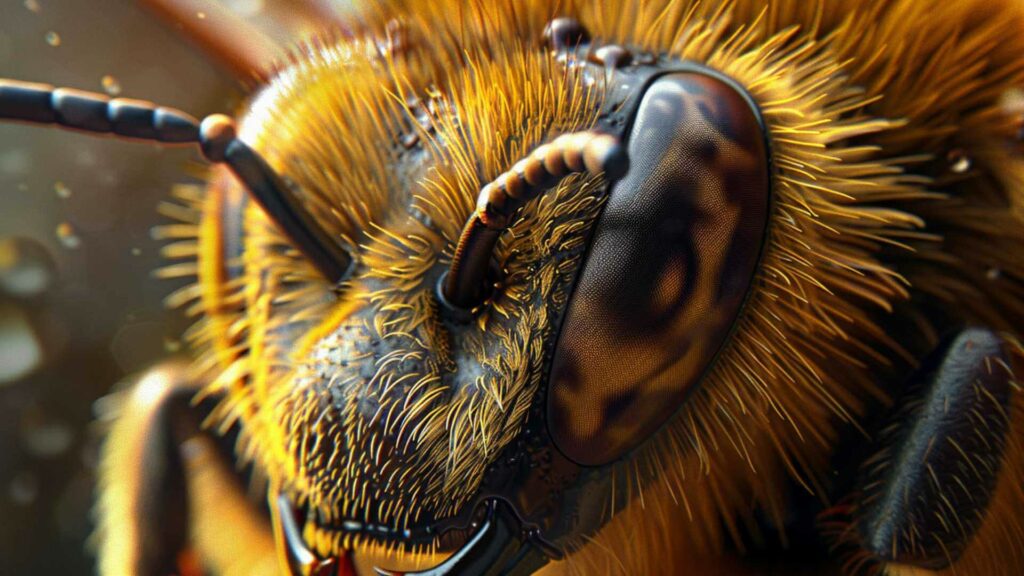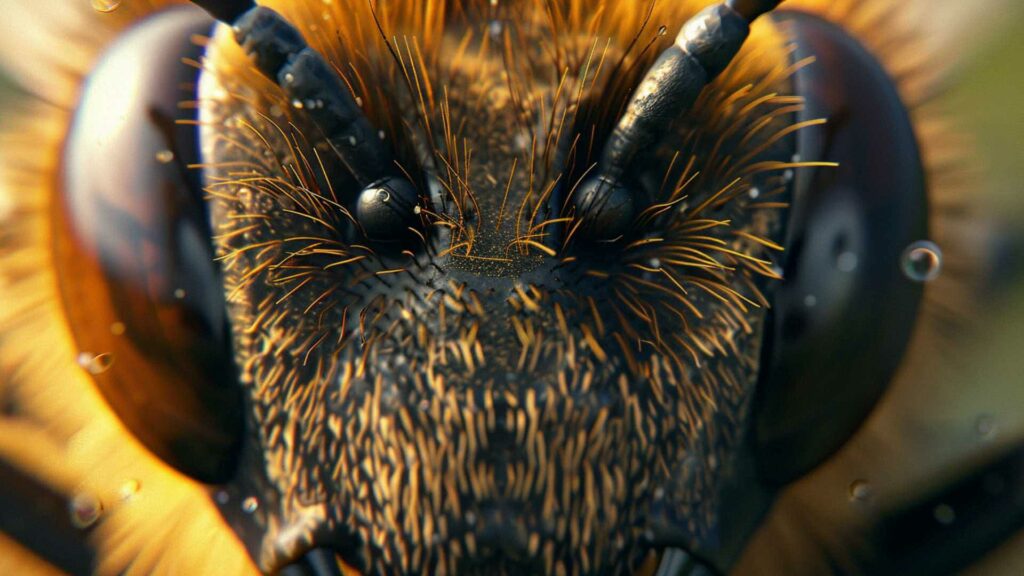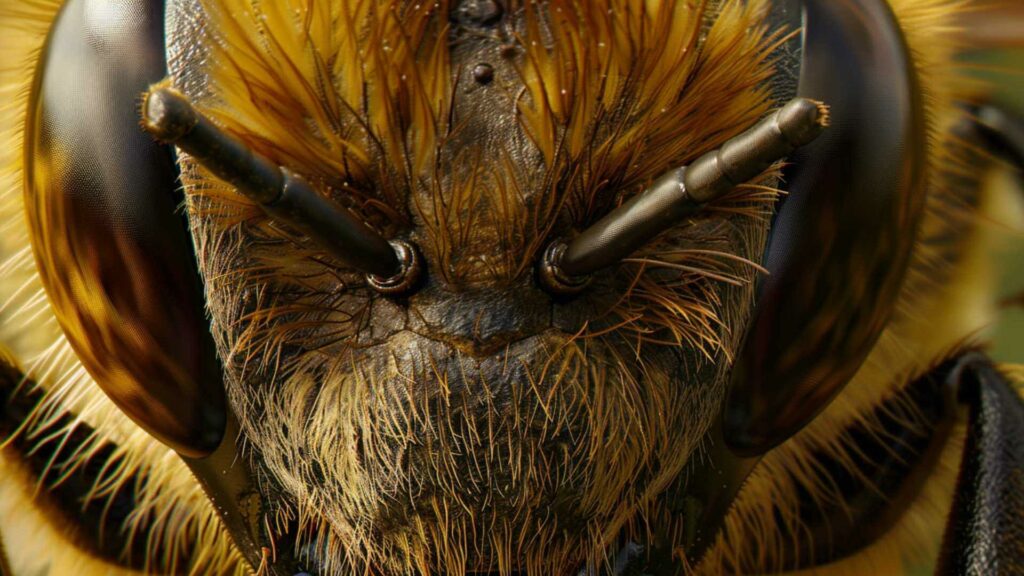Have you ever considered seeing the world like eyes does a bee? While exploring bee anatomy and insect vision, an intriguing question arises: Do bees really have five eyes? This idea makes us rethink what vision means. Honeybees, the busy pollinators adding life to our gardens, see the world differently from us. This sparks our curiosity about their unique way of seeing. In our journey, we’ll discover the secrets of bees’ eyes and how this helps them navigate with precision.
Introduction: A Glimpse into Bee Anatomy and Vision
My interest in honeybees has driven me to dive deep into their visual system, which is critical to survival. We’ll look at their compound eyes and ocelli, laying the groundwork for how bees view the world. Join me as we take a closer look at the surprisingly complex and sophisticated vision of these seemingly simple insects.
Key Takeaways
- Discover the truth about whether honeybees have five eyes and its implications.
- Learn about the unique structure and function of bee anatomy related to insect vision.
- Understand the distinctions between compound eyes and ocelli in bees.
- Gain insight into how bees perceive their environment and the importance of their vision in daily activities.
- Dive into the scientific explanations illuminating honeybees’ navigational prowess through their visual system.
- Look at how bees’ vision is optimized for vital tasks like pollination.
Introduction: A Glimpse into Bee Anatomy and Vision

Exploring the world of bees reveals their complex anatomy and stunning vision. They have two types and shapes of eyes – compound eyes and ocelli. This blend gives them exceptional insect vision abilities.
The compound eyes are fascinating. Each has two large eyes and one has thousands of tiny lenses. They work together to give bees a broad view of the world. These eyes are great at spotting movement and helping bees find flowers.
The ocelli are the larger eyes more straightforward eyes on top of a bee’s head. They don’t see details but sense light intensity. and detect motion. This is key for knowing which way to go. Together, these eyes help bees do their daily tasks.
- Compound Eyes: Thousands of lenses giving a comprehensive view and detecting motion
- Ocelli: Light-sensing eyes are vital for figuring out the direction
I want to take you on a journey into bee anatomy. We’ll see the world as they do, which is different. Let’s dive into the fantastic vision of bees.
The Fascinating Structure of Bee’s Eyes
The bee visual system is genuinely intriguing, especially the complex design of their eyes. It feels like entering an alien yet fantastic world. We start with their large compound eyes themselves, which are for more than just seeing. They play a crucial role in bee survival, shaping their interaction with the world. Join me to explore how these eyes work and their importance in a bee’s life.
Understanding Compound Eyes
Compound eyes comprise tiny lenses, each adding to the bee’s view. These compound eye – structures with multiple lenses – are common in insects, with each lens attached to light-sensing cells. This setup lets bees detect fast movements and see almost all around them. It’s an essential part of their visual system, helping bees find nectar and pollen efficiently.
A Closer Look at Bee Ocelli: The Simple Eyes
Ocelli might seem simple, hairy eyes, but they play a significant role. These three small eyes help with orientation and are found on the top of a bee’s head. They use light, especially from the sun, for their fantastic navigation skills. Ocelli doesn’t create complex images but provides critical light information. This info and compound eyes guide bees throughout their active lives.
Do Bees Have 5 Eyes

Have you ever wondered about honeybee anatomy? A question that often comes up is: Do honey bees have five eyes? This isn’t only interesting to casual readers but also important for experts. Those who study bee eyes look into how bees see their world. They do this to understand bees’ role in pollination and our ecosystem.
Let’s dig into the science behind honeybees’ eyes. We’ll look at what research says about their eyesight. This helps us find the truth about the bee’s eyes. Are all five dots on a bee’s face eyes? We’ll uncover this by looking at their honeybee anatomy.
- Anatomical Insights: Understanding the honeybee’s head structure and ocular configuration
- The Compound Eyes: Exploring the giant, multifaceted eyes on either side of a bee’s head
- Ocelli’s Tale: Shedding light on the trio of simple eyes located on the bee’s forehead
- Functionality and Vision: How the number of eyes a bee has enhances their perception and survival
This journey is more than just confirming a fact. It’s about recognizing the advanced biology that helps bees succeed. Keep up with us as we delve into the honeybee’s visual system. It is one lens’s as unique to bee species as it is crucial for their daily lives.
The Functional Dynamics of Bee Vision
Exploring the world of bees, their extraordinary abilities capture my interest. It goes beyond their crucial role in pollination. Their vision is a marvel, filled with vibrant colors, navigational wonders, and complex signals. I’m excited to share about the beauty and function of bee vision.
How Bees Perceive Colors and Ultraviolet Light
Bees see a world with more colors than we can imagine. They can see ultraviolet (UV) colors, which is fascinating. This lets them see patterns on flowers that we can’t see. By seeing in UV, they find nectar, helping with pollination. It’s more than survival; it shows the artistry in nature.
The Role of Vision in Bee Navigation and Communication
Navigation is another area where bee vision is critical. It helps them fly smoothly from flower to hive. Their sharp vision helps them navigate and remember where to find the best food. Vision is also crucial in their communication. The ‘waggle dance’ is a visual message guiding them to food. It shares information on where the good stuff is through a dance.
- Perception of Ultraviolet Markers – Bees can detect UV patterns on flowers, like neon signs pointing to nectar.
- Color-coded Maps – Their vision enables them to associate specific colors with food sources, creating a mental map of where to feed.
- Waggle Dance Decoding – Vision helps decipher the movements of the waggle dance, facilitating the sharing of information within the hive.
Understanding bee vision helps us appreciate these insects more. Their UV vision improves foraging, while their navigation skills ensure they return home. Their visual skills also bring the entire body hive together towards a common goal. Studying bee vision has grown my respect for these small but mighty navigators.
Comparing Insect Physiology: Bees Versus Other Insects

Honeybees stand out with their complex bodies when exploring the world of insects. Their eyes are not just for seeing; they help bees be amazing pollinators. Let’s dive into how honey bee’ senses compare to those of other insects.
Distinguishing the Vision of Honeybees from Other Pollinators
Honeybees see differently, which is critical for their job as pollinators. But what makes their sight unique? They can see ultraviolet light. This skill lets them find many flowers invisible to others.
The Uniqueness of Bee Sensory Organs
The sensory world of bees is genuinely fascinating. They have advanced eyes that give them excellent vision. This better vision is crucial for finding flowers and talking through dances.
- Superb navigational skills leveraging polarized light.
- Sensitivity to minute changes in the environment, thanks to Johnston’s organ.
- A keen sense of smell complements their vision, making honeybees top-tier pollinators.
Honeybees show us how special features can lead to success. Their large eyes and remarkable senses give them an edge in nature.
Conclusion: Reflecting on the Intricacies of Bee Vision
We’ve looked deeply into the world of honeybees. Their vision is far more complex and vital for survival than we thought. They have compound eyes and sensory perception that are perfect for their needs. This lets them navigate and do tasks like foraging and pollination very well.
The more I learn about bee vision, the more amazed I am by nature’s balance. Honeybees’ perception of the world is crucial for their lives. This biological balance helps bees and their ecosystems thrive. It shows us how life is deeply connected and why every species matters.
Studying bee vision helps us appreciate these hard-working pollinators more. Bees’ navigational abilities are examples of nature’s genius. By understanding bee vision, we respect bees more and realize the most bees need to protect their homes. Nature has given bees all they need to survive. Now, it’s our job to help them thrive in our world.
Neutralize Bees with D-Termination: The Leading Pest Control in Las Vegas!

Dealing with bee problems on your Las Vegas property? Trust D-Termination to help. Our skilled team specializes in eliminating bee infestations, restoring comfort and peace to your space. Bid farewell to bees—choose D-Termination for effective pest control today!
Reach out to us at 702-919-6310 or visit dtermination.com to schedule your bee control service and reclaim your space from these bothersome insects.
FAQ
Do bees have five eyes?
Yes, bees have five eyes. They have two large, called compound eyes, on the sides and three smaller, called simple eyes, or ocelli, on the top of their heads.
What is the difference between compound eyes and ocelli?
Compound eyes have many tiny cells that help bees see around them. Ocelli, the more straightforward eyes, have sensory cells that sense light intensity to help with flying and knowing where they are.
How do bee eyes differ from human eyes?
Unlike human eyes, bee eyes have thousands of tiny lenses. They can see ultraviolet light, which humans can’t. They can also see more widely and detect different angles and movement faster how many eyes.
How do bees use their eyes for navigation?
Bees rely on their eyes to find their way. The compound eyes spot landmarks. The three ocelli that help keep flight steady and guide them by the sun’s position.
Are bees colorblind?
Bees are not colorblind. In fact, they see colors, including ultraviolet ones, that we can’t see. This helps them find different flowers to collect nectar.
What makes bee vision unique compared to other insects?
Bee vision stands out because they can see ultraviolet light. They also have a comprehensive view and spot patterns well. This is key for finding flowers and navigating.
How does bee vision contribute to their survival?
Bee vision plays a huge role worker bees in their survival. It lets them find food, return home, talk through dances, and spot dangers around them.







